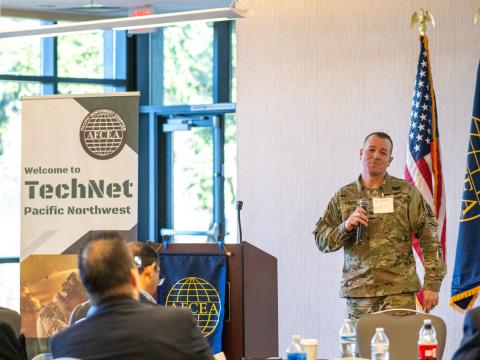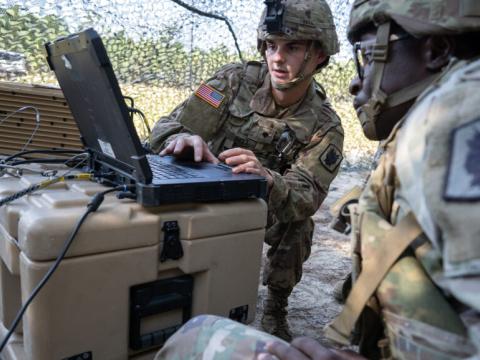Mobile Routers To the Rescue
 |
| IBM and Cisco System’s Crisis Management Services for Crisis Response capability offers business and government organizations access to communications equipment in a disaster. The service provides a fleet of vehicles and deployable systems such as routers and satellite communications capabilities that can be deployed to a disaster site within 24 to 48 hours. |
Confusion is common in disaster relief operations. Destruction of infrastructure, inefficient coordination among participating organizations and lack of interoperability between communications systems contribute to the operational fog that surrounds first responders. Crisis management services help abate the confusion in such operations by providing interoperable equipment and software that can be deployed quickly for various scenarios.
Of the various commercially available crisis management systems, one launched in April 2007 is unique because it features a range of global capabilities, rapidly deployable assets, supporting infrastructure and experienced personnel. The IBM Crisis Management Services for Crisis Response consists of a combination of communications, collaboration and coordination technologies and satellite and wireless capabilities that allow civilian and government groups to prepare for, respond to and rapidly recover from a disaster. A joint effort between IBM and Cisco Systems, the service integrates a variety of hardware, software and service capabilities into an emergency response communications network.
Both IBM and Cisco have been closely involved in business continuity operations for many years, notes Charles Largay, IBM’s global crisis management executive,
The service consists of a series of packaged capabilities geared toward supporting customer communications and information distribution needs during times of crisis or emergency. These systems can manage a range of security levels from commercial traffic up to Type 1 encryption. “We’re not going to be incident commanders. We may provide advice to them, but we are essentially the communicators. We can move voice, video and data and put it anywhere someone needs to get it,” explains Largay.
The smallest packages are called Go-Kits. These are satellite and voice systems that can be carried into a disaster area by two people. Largay notes that this kit can be used by small forward evaluation teams or as an initial relief station in a remote location. The Go Kits allow advance teams to assess a situation and contact command centers with an accurate estimate for a disaster’s particular circumstances and the equipment needed to support recovery operations.
Largay adds that the service also includes a number of virtual teams that can be on the ground at a disaster site within 24 hours. He describes these groups as “volunteer firemen” in the sense that they are well trained but normally work in other positions within the two companies. These personnel are retasked from their day-to-day assignments to meet emergency customer needs.
The service also has a tactical kit to support larger groups of people. Largay explains that this system is more robust and able to connect more personnel to different types of communications sources. The tactical kit’s capabilities include the ability to access large V-Sat dishes and to link into surviving infrastructure or wireless systems, such as worldwide interoperability for microwave access, or WiMAX, networks. The tactical kits can be configured to support specific user requirements.
Another level of the service is incorporated in a family of vehicles ranging from four-wheel drive trucks to truck-size command vehicles. Largay adds that the command vehicles were recently demonstrated at a Federal Emergency Management Agency (FEMA) event commemorating firefighters killed in the past year. Because many relatives of the deceased could not attend in person, FEMA approached IBM to provide a live Web-based broadcast for these families. One command vehicle was used to digitize the event’s video feed and to transmit the feeds via satellite and fiber optic cable. The feed went into IBM’s backbone and then through the company’s media distribution servers for worldwide distribution.
The IBM/Cisco team also supported the
Both companies maintain a reserve of equipment for emergencies, and they provide teams of skilled personnel to offer support and expertise. Another of the service’s capabilities is providing back-end support to reroute networks and leverage IBM’s own commercial and private networks. Largay adds that IBM can reach back and contact the personnel who designed and built specific networks if a challenging situation is encountered in the field.
 |
| One of the systems provided by the IBM/Cisco service is the tactical communications kit. This suitcase-size unit includes a satellite antenna providing up to 300 kilobits per second of voice or data bandwidth that can be shared with wired and wireless telephones and computers. |
Both IBM and Cisco contribute to the service’s pool of deployable vehicles and equipment. Largay notes that Cisco operates the majority of the vehicle fleet, while IBM contributes smaller mobile assets. These small units—usually manportable satellite communications systems such as the Go Kits—can be delivered into rugged areas where larger vehicles cannot be deployed rapidly or easily.
Although they work with client organizations to arrange transport, both firms will use their own assets to move equipment to an emergency event. “Our people go out in the field with their own food and medical supplies. We have the whole capability from soup to nuts,” Largay maintains.
Federal, state and local groups can access the service through a number of contract vehicles. However, Largay notes that it is preferable to conduct contingency planning before any event takes place. He observes that disaster contingencies have their own continuum that involves training, planning and preparation. Disasters vary in size, scale and intensity and are then followed by a recovery period. The service has the ability to operate in all of these roles, he says.
The service’s tactical groups try to work ahead of situations, monitoring events such as weather and geopolitics. The teams also examine long-term issues such as projected regional water shortages. If flooding had occurred, for instance, the teams could monitor the situation and might have material on its way to the scene before local organizations request support. Largay notes that the service draws up operational plans with its clients to support rapid deployments for a range of potential disasters.
IBM monitors events from command centers in
Prior to going public with the disaster response capability, IBM and Cisco participated in the Strong Angel III exercise (SIGNAL Magazine, November 2006). Largay shares that Cisco provided a vehicle to support a large network core while IBM brought in a predecessor to the Go Kit. During the exercise, a large portion of the IBM staff also supported the logistics necessary to operate the multi-agency network that the exercise depended on.
Largay notes that even before the service’s official rollout in April, it was employed to help the
IBM and Cisco continue to enhance the service’s capabilities. Largay notes that the firms are upgrading several of their follow-on kits, such as the Fog-Cutter kit, which is an IBM design. This system was first deployed in 2003 to support disaster management efforts for the series of hurricanes that hit
The service now offers high-definition videoconferencing over satellite links up to and including Type 1 encryption between the support vehicles and headquarters or between two vehicles if necessary. Largay explains that the service’s premium model includes upgrades in the cost basis; that is, if an improvement or capability becomes available that gives customers enhanced service or performance, it is included in the support.
If a customer has an existing communications vehicle, IBM and Cisco will retrofit the vehicle and provide a separate contract to keep the equipment current. Largay notes that many government procurements are for equipment only and usually do not provide long-term support. He believes that federal and state organizations are at the beginning of a capital expenditure crunch. One of the goals of the service is to make system upgrades affordable at the state and municipality level. “Disasters tend to be like politics—they’re local. There are a lot of places in this country that have these recurring similar types of events, such as floods or fires. That’s a big disaster in a small town,” he says.
Web Resources
IBM Crisis Management Services for Crisis Response: www.ibm.com/services/us/index.wss/offering/bcrs/a1027323
Cisco Systems: www.cisco.com
FEMA: www.fema.gov




Comments